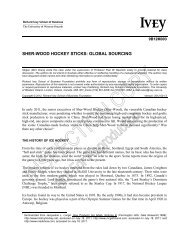foundation of canada asia pacific - Content Tagged with
foundation of canada asia pacific - Content Tagged with
foundation of canada asia pacific - Content Tagged with
You also want an ePaper? Increase the reach of your titles
YUMPU automatically turns print PDFs into web optimized ePapers that Google loves.
similar to that <strong>with</strong> the US <strong>with</strong> only three other countries — Mexico, Chile and<br />
Israel. These countries, none <strong>of</strong> them economic giants, accounted for just 1.7% <strong>of</strong><br />
our total trade in 1998, compared <strong>with</strong> the 77% accounted for by the US.<br />
The way to rectify any imbalance brought about by North American free trade is clearly<br />
not to forgo the access we have gained to the US, but to seek similar levels <strong>of</strong> access to<br />
other major regions, notably Asia. The government has pursued this objective globally<br />
through the GATT and WTO, and regionally through such groupings as APEC and the<br />
Free Trade Area <strong>of</strong> the Americas. Worthy as these efforts may be, they are very long term<br />
— the GATT/WTO process has been under way for some 52 years and still has a long way<br />
to go. APEC’s vision <strong>of</strong> free trade in Asia Pacific is not due to be fully realized until<br />
2020, and could well run out <strong>of</strong> steam long before that. A shorter-term solution would<br />
be to seek free-trade and investment agreements <strong>with</strong> other major trading partners,<br />
especially our second-largest partner, Japan. These would be intermediate steps toward<br />
broader economic liberalization, and would help <strong>of</strong>fset the policy bias that now appears<br />
to exist toward the US. Once negotiations began, they would promote debate on the<br />
distortion NAFTA has brought to our economic relationships and send business a signal<br />
about looking for markets beyond the US. There is no reason this should detract from<br />
Canada-US investment or trade. Rather it would likely stimulate interest and develop a<br />
greater level <strong>of</strong> expertise in areas <strong>of</strong> trade and investment that are currently neglected<br />
due to ignorance. Once major Canadian companies or institutions began investing in, say,<br />
Japan, the way they now do in the US, Toronto stock analysts would quickly develop an<br />
interest in Japanese investments.<br />
47<br />
A BALANCING ACT<br />
Growing integration, or at least interdependence, is the outstanding feature <strong>of</strong> today’s<br />
global economy. The integration is far from even, focused on clusters <strong>of</strong> countries in North<br />
America, Europe and East and Southeast Asia. There are few signs <strong>of</strong> significant crossborder<br />
integration in Africa or South Asia and it is relatively less developed in Latin<br />
America, despite efforts underway to create a free-trade area linking North and South<br />
America. The pattern <strong>of</strong> integration is also very uneven <strong>with</strong>in countries, concentrated<br />
in certain industries, especially electronics and high tech. However, the general trend is<br />
for greater cross-border integration. As argued in What is Globalization? in Chapter 1(page<br />
12), this integration, whether regional or global, is the result <strong>of</strong> the interaction <strong>of</strong> a series<br />
<strong>of</strong> developments in technology, communications and transport. It is not directly the result<br />
<strong>of</strong> policy decisions by any government or international body like the WTO. However,<br />
policy choices, especially decisions to remove direct and indirect barriers to flows <strong>of</strong> goods,<br />
people or capital, establish the framework <strong>with</strong>in which these factors interact. They can<br />
have a considerable influence on the resulting pattern <strong>of</strong> industries.<br />
Ideally, policy should be balanced, not unduly favouring any <strong>of</strong> the elements at work in<br />
the integration process. It should also touch on the broadest possible range <strong>of</strong> a country’s<br />
economic relationships. Of course, in the real world <strong>of</strong> politics and entrenched interests,<br />
it is impossible to advance on all fronts simultaneously. In the case <strong>of</strong> Canada and the<br />
US, the flow <strong>of</strong> goods and capital between the two countries has been liberalized to a



